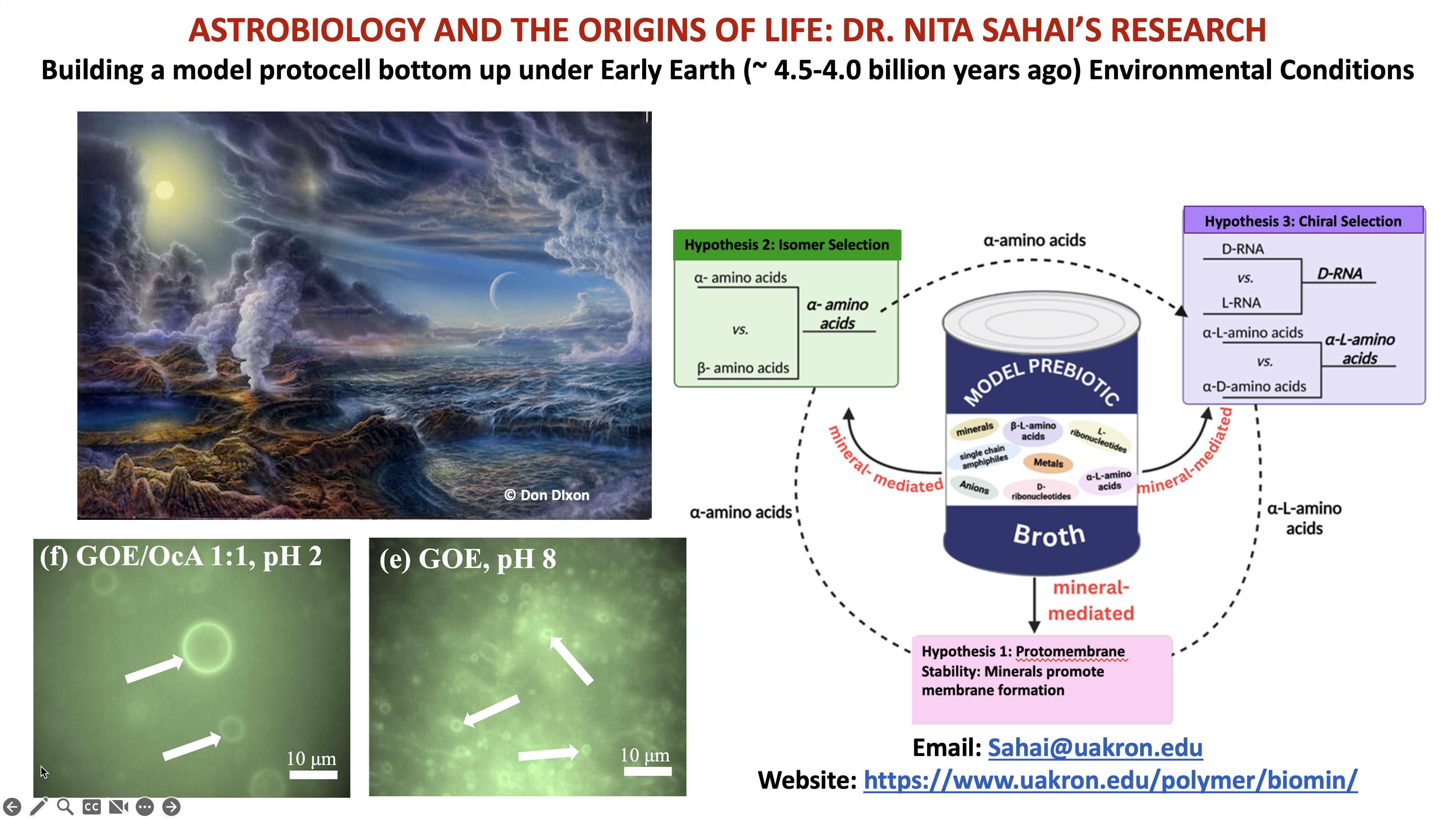Tiered Mentoring Program
Astrobiology and the origins of life: Making novel prebiotic membrane-forming molecules with mineral catalysts
Dr. Nita Sahai, Professor and Ohio Research Scholar of Polymer Science and Polymer Engineering
 The Earth is 4.56 billion years old and the earliest evidence for life is found in rocks about 4.0 billion years old. The Sahai lab’s research on Origins of Life focuses on how a planet composed on only atmosphere, water and rocks can come to be inhabited by life in energy environmental niche explored to date, that is, the Transition from Geochemistry to Bio(geo)chemistry. We conduct model prebiotic biomolecular synthesis and self-assembly reactions catalyzed by minerals and inorganic ions in the absence of any enzymes, which are produced by life itself, with the ultimate goal of building a protocell from the bottom-up. This area of research is called Astrobiology/Prebiotic Chemistry/Origins of Life.
The Earth is 4.56 billion years old and the earliest evidence for life is found in rocks about 4.0 billion years old. The Sahai lab’s research on Origins of Life focuses on how a planet composed on only atmosphere, water and rocks can come to be inhabited by life in energy environmental niche explored to date, that is, the Transition from Geochemistry to Bio(geo)chemistry. We conduct model prebiotic biomolecular synthesis and self-assembly reactions catalyzed by minerals and inorganic ions in the absence of any enzymes, which are produced by life itself, with the ultimate goal of building a protocell from the bottom-up. This area of research is called Astrobiology/Prebiotic Chemistry/Origins of Life.
A long-standing question in the Origins of Life field is whether RNA, enzymes (proteins) or lipid membranes evolved first because in extant biology, each requires the other. However, a fundamental property of almost all known living systems is that they are mutually-codependent and are optimized to thrive in their ecological niches. Universal biomolecular features across all phyla (e.g., homochirality, mainly 20 proteinogenic amino acids and four nucleotides, 3’,5’-phosphodeister bond linkages in nucleic acids) suggest their emergence in a shared environment. We postulate therefore that prior to the emergence of cellular ecosystems, a protobiogeochemical “geomolecular ecology” existed, that was predicated on the principles of Mutualism, Selection, Catalysis by minerals and dissolved ions in the Origins of Life. Thus, we are building RNA, peptides and protocell membranes under pressure, Temperature, pH, etc. environmental conditions that were plausible on Earth ~ 4.5-4.0 billion years ago using minerals and metal ions as catalysts.
The Tiered Mentoring project will involve making novel prebiotic membrane-forming molecules with the help of mineral catalysts. The undergraduate student should ideally have some experience with making aqueous solutions and measuring pH. If they do not, then we can train them. They will also learn how to use HPLC for determining if the unique molecules have formed, and will also learn how to visualize protocell membranes under a fluorescence microscope. They will help design the experiments and interpret the data with the help of a graduate student, a post-doctoral research scientists and Dr. Sahai. They will have regular meetings with all of us when they need help, and also will participate in the Sahai group’s weekly research meetings, if they are interested to join. Their work will be included in a scientific journal publication from the Sahai Lab, if it meets the appropriate standards.
The Sahai lab has previously had many Biochemistry Major undergraduate students conduct their Honors thesis project in the Origins of Life field. This field brings together concepts and methods from Biology, Chemistry and Earth Sciences, thus truly teaching students to think creatively across traditional disciplinary boundaries.
